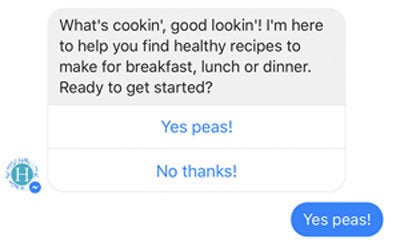
Welcome to HuffPost’s Keeping It 100. From infusing our culture with data to figuring out how to reach Gen Z and cultivate niche distributed communities, we’ll give you an inside look at the hits and misses of HuffPost’s biggest bets.
Developing deeper relationships with our readers is a big priority for HuffPost. So when Facebook Messenger announced its bot platform in April 2016, we were excited.
The platform offered us the opportunity to connect with our audience on a one-to-one level in a way that was actually scalable. We hit the ground running, and in the last few months, we’ve launched three different experiments: a bot that provides recommendations for what to watch on Netflix, another that helps you decide what to cook, and a third that sends breaking news alerts about President Donald Trump’s first 100 days in office.
No one has completely mastered the space yet. But in our trials, we’ve learned a lot about how brands can use bots to interact with their audiences. If you’re creating a bot, here are a few things you should keep in mind:
Think about the service you’re providing for your audience. Before we set out to build our first bot, we thought a lot about the “why.” Why would people use a bot to engage with our content, as opposed to finding us on social or downloading our app?
We knew we needed to build a bot that would provide a daily utility for our audience, so Netflix recommendations from our editors that were tailored to each user’s needs and interests made a lot of sense. How often do you sit down in front of your TV with no idea what to watch? We launched in early July and were pleasantly surprised with the results. In the first month, more than 50 percent of people who interacted with the bot used it more than once.Be conversational. Chatbots are a unique opportunity to give your brand a voice. Bots that sound like, well, robots are really boring. In all three of our projects, we approached the dialogues as if we were chatting with a friend. We wrote in the first person and threw in a few corny jokes:

Craft multiple responses for each interaction. The goal for our bots has been to create a sticky experience that users return to repeatedly. With that in mind, we realized that when users interacted with our Netflix recommendations bot repeatedly, they encountered the same user flow multiple times. To avoid that repetition, we created at least five to 10 versions of each response and then rotated those responses in each user flow. It doesn’t completely solve the problem ― but it helps.
Monitor your audience’s interactions. While our bots provide suggested messages to guide the conversation, we’ve noticed that a fair amount of users are actually typing in their own responses in Messenger. Some of the most frequent responses we get are “Hello,” “OK,” and “Thank you.” If you’re building a bot, think about implementing automatic replies for the most commonly typed-in responses to provide a more dynamic experience.
We also made a few mistakes along the way. Here are three things we quickly learned not to do:
Don’t skimp on your promotion plan. When we launched our Netflix recommendations and recipe bots on Messenger, we planned a big initial push ― but didn’t really think about how we’d promote long-term. It’s key to consistently promote your bot to maintain an active user base, especially for bots that require users to initiate conversations.
We took a different approach with our Trump bot. Prior to launching, we outlined every possible avenue for promotion, and we’ve continued to promote it even though it’s been live for a couple months. While there are multiple routes for bot promotion, including organic and paid posts on Facebook, on-site promotion in individual articles has proved to be the most successful acquisition tactic for us:

Don’t think your bot won’t fail. It will. People love to try to break bots, and it’s impossible to craft responses for every user input. We learned early on to be ready with fun, somewhat self-deprecating error messages when we get a response we didn’t plan for. It’s important that our audience knows we’re still learning, too.

Don’t stop iterating. Chatbots are still new and the industry is still figuring out what works and what doesn’t. It’s not enough to just launch a bot and wait for it to take off. A great bot experience involves consistent monitoring and iteration. We’re looking to experiment with a few more experiences this year, including increased interactivity, the collection of UGC and enhanced personalization. We have a ways to go, but we’re excited about the future.

Want to know the latest in media, metrics and reality TV? Sign up for “On The C.”
